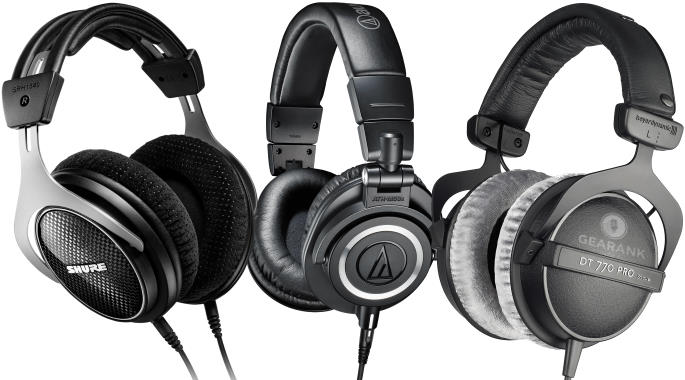
Whether you’re a professional musician, producer, or simply a passionate audiophile, finding the perfect pair of closed back headphones can significantly enhance your recording experience. In this comprehensive guide, we’ll explore the top closed back headphones across different price ranges and categories.
Disclosure
We recommend all products independently of 3rd parties including advertisers. We earn advertising fees from:
• • • • •

• • • • •
Amazon
As an Amazon Associate we earn from qualifying purchases.
• • • • •
More Headphones
There are different types of headphones used in music production Closed-back headphones are a type of headphones that have a sealed ear cup design, which prevents sound from leaking out or in. They are commonly used in recording, mixing, and monitoring situations in studios, as they offer better isolation and less distraction from external noise. They also provide a stronger bass response and a more immersive sound than open-back headphones, with a vented ear cup design that allows some sound to escape.
However, not all closed-back headphones are created equal. There are many factors to consider when choosing the best closed-back headphones for your needs like:
- Sound Isolation: Choose headphones with good noise isolation to minimize sound bleed into your microphone during recording.
- Comfort: Comfortable headphones are a must for long recording sessions. Look for lightweight designs with plush cushions and adjustable headbands to ensure maximum comfort and minimal distraction.
- Frequency Response: Balanced frequency response is key for accurate monitoring. Choose headphones that cover the entire audible spectrum without exaggerating any particular range.
- Durability: Choose durable studio headphones with strong materials, reinforced cables, and replaceable parts to withstand wear and tear.
- Cable Length and Detachability: Longer and detachable cables are more flexible, convenient for storage, and replacement.
- Impedance: Headphones with lower impedance (around 32 ohms) are suitable for portable devices, while higher impedance headphones (above 250 ohms) may need dedicated headphone amplifiers.
Whether you are a professional audio engineer, a musician, a producer, or a hobbyist, you will find this guide helpful and informative. We have also included the specifications, features, pros, and cons of each headphone and links to where you can buy them online. By the end of this guide, you will have a better idea of which closed-back headphones are best suited for your studio needs.
If you need more information about the difference between open back vs closed back headphones, click here.
The Best Closed Back Headphones for Recording
| Gearank* | SRC* | Check Price | ||||||
|---|---|---|---|---|---|---|---|---|
| Budget Option | ||||||||
 | Audio-Technica ATH-M20x | 91 | 23650+ | |||||
| Under $150 | ||||||||
 | Sony MDR-7506 | 94 | 29750+ | |||||
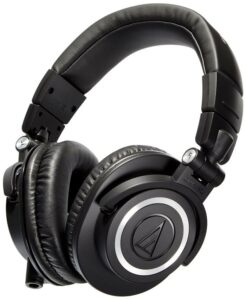 | Audio-Technica ATH-M50x | 94 | 30100+ | |||||
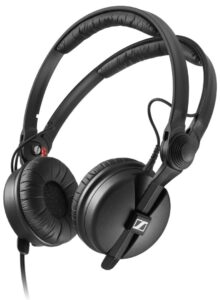 | Sennheiser HD 25 | 95 | 1100+ | |||||
| Under $200 | ||||||||
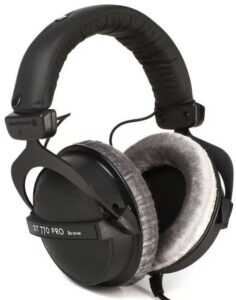 | Beyerdynamic DT 770 PRO (80 Ohm) | 94 | 21950+ | |||||
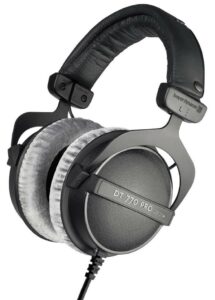 | Beyerdynamic DT 770 PRO (250 Ohm) | 94 | 15550+ | |||||
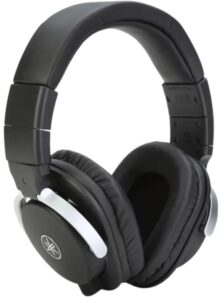 | Yamaha HPH-MT8 | 92 | 200+ | |||||
| Under $500 | ||||||||
 | Beyerdynamic DT 150 | 91 | 500+ | |||||
 | Beyerdynamic DT 700 PRO X Closed-Back Studio Headphones | 92 | 1100+ | |||||
Best Closed Back Headphones Under $50
Audio-Technica ATH-M20x
Cons
- Fixed cable
- Lacks bass
Pros
- Comfortable to wear
- Rugged
- Good isolation
- Lightweight
The Audio-Technica ATH-M20x is affordable for those seeking studio-style headphones without breaking the bank. Priced around USD 49, it is one of the best options for budget-conscious buyers. The build quality is lightweight but cheap due to its plastic construction. However, there are metal reinforcements in critical areas.
The ATH-M20x offers a relatively neutral sound profile, which is excellent for accurate monitoring. The bass response is quiet, and the overall sound signature is balanced. The 40mm drivers deliver precise and clear midrange and treble frequencies. While the vinyl-covered ear pads may feel unforgiving after prolonged use, the omission of a silver Audio-Technica logo on the ear cups gives the headphones a surprisingly premium look.
The fixed audio cable (3 meters long) might be a drawback for some users. However, bedroom music producers on a budget will appreciate the attractive price-to-performance ratio. Podcasters will find the relatively accurate frequency response useful. Studio owners can use these headphones during tracking without worrying about their affordability.
In summary, the ATH-M20x is a solid choice for those who need studio headphones without spending too much. While it may have only some of the bells and whistles of higher-priced models, it does the job without compromising sound quality. Despite its plastic construction and vinyl-covered ear pads, the headphones are lightweight and comfortable for extended use.
Specifications
- Driver Size: 40mm
- Magnet Type: Neodymium
- Frequency Response: 15Hz-20kHz
- Sensitivity: 96 dB
- Weight: 0.42 lbs. (without cable and connector)
- Connectivity: 1/8", 1/4" adapter
Best Closed Back Headphones Under $150
Sony MDR-7506
- Not meant for long use
- Clear midrange with slight treble bump
- Useful for both tracking and mixing
- Good quality build
- Detailed bass, no bloat in frequencies
The Sony MDR-7506 is a long-running product in Sony's headphone line. It has remained mostly unchanged over its nearly 30-year run with the exception of the switch from Samarium Cobalt magnets to Neodymium early on.
It features a 40mm Neodymium Driver that gives just the right amount of low end without making the lower midrange too bloated or pushed.
They have a mostly flat midrange with a slight lift in the treble region for more detail. This, together with its closed back design, makes the MDR-7506 a Swiss Army knife in the studio. It is able to handle tracking and mix referencing tasks well. It's not the most neutral sound but it helps you hear standout frequencies during mixing.
They have great background noise isolation which is ideal for tracking. Sound leakage is kept to a minimum and is one of the quietest cans in the market with regard to ambient noise.
Speaking of closed back, comfort can be an issue because the ear cups tend to get hot when used for long periods.
Overall quality of the headband, speakers, and padding is up to the usual high standards of Sony.
The MDR-7506 has been a studio staple for decades. Its exceptional sound, versatility, and durability have earned it legendary status. It's one of the best closed back headphones for tracking and monitoring.
Specifications
- Driver Size: 40 mm
- Magnet Type: Neodymium
- Frequency Response: 10 - 20,000 Hz
- Impedance: 63 Ohms
- Sensitivity: 106 dB/W/m
- Max Input Power: 700 mW at 1 kHz
- Weight: 9.52 oz.
- Connectivity:9.8 ft. coiled cable Connection, 1/8" Gold plated stereo jack plug, and 1/4" adapter (6.35 mm)
Audio-Technica ATH-M50x
- Proprietary locking connector
- Neutral and revealing sound
- Balanced mids and highs
- Deep bass without being too boomy
- Solid and reliable
- Vegan-friendly faux leather earcups
A darling for many studio engineers, the ATH-M50x is a staple for large, small, and mobile studios for an unmistakable sound signature that is neutral enough to make critical mix decisions with.
It has 45mm drivers that provide a tight bass response without it being out of proportion to the mids and highs. This way it truly reveals the natural state of your mix, resulting in adjustments that translate well with real-world speakers.
Everything about it feels solid and reliable, not that much different from high end headphones. Even the faux leather ear cups feel good. It fits nicely and is reasonably comfortable.
Audio-Technica is widely considered as one of the best headphone brands today, and the ATH-50x lives up to the company's quality standards.
With many hit albums produced and mixed using these headphones, there is absolutely no reason not to get these for recording.
Specifications
- Driver Size: 45 mm
- Magnet Type: Neodymium
- Frequency Response: 15 Hz to 28 kHz
- Impedance: 38 ohms
- Sensitivity: 99 dB
- Max Input Power: 1,600 mW
- Weight: 10 oz (285 g) without cable and connector
- Connectivity: 3 cables in total - Detachable 9.8' (3 m) straight, and coiled cables + a single 3.9' (1.2 m) straight cable all with 1/8" plugs + a 1/4" screw-on adapter.
Sennheiser HD 25
Cons
- On-ear design may be uncomfortable
- Doesn't fold
Pros
- Lightweight
- Swiveling ear cups great for DJs
- Good build quality
- Spare parts readily available
The Sennheiser HD 25 headphones are a well-known and highly regarded choice for DJs, producers, and audiophiles. Their exceptional performance, durability, and unique design have made them a go-to choice since they emerged in the late '80s. The headphones deliver accurate reproductions and excellent sound quality, making them ideal for use in loud clubs or studios.
The HD 25's closed-back design effectively isolates external sound sources, making them perfect for monitoring in loud environments. Additionally, DJs love the ability to swivel one ear cup away while mixing, allowing them to hear the crowd or monitor the room without removing the headphones. The headphones are also lightweight and comfortable, with adjustable ear cups and a dual headband.
Although the on-ear design and tight fit may not suit everyone's preferences, the HD 25 headphones are a reliable choice for professionals and enthusiasts who prioritize sound quality, durability, and noise isolation. Sennheiser also offers replacement parts, extending their lifespan and making them a reliable choice. If you're serious about your audio gear, the Sennheiser HD 25 headphones won't disappoint.
Specifications
- Driver Size: 40mm
- Magnet Type: Neodymium
- Frequency Response: 16Hz-22kHz
- Sensitivity: 200 dB
- Weight: 0.3 lbs.
- Connectivity: 1/8" plug, 1/4" adapter
Best Headphones Under $200 - Closed Back
Beyerdynamic DT 770 PRO (80 Ohm)
- The cable is not detachable
- Balanced midrange and treble
- Smooth low-frequency bump
- Easier to integrate into home studios
- Smooth low frequency bump
The DT 770 PRO series comes in 3 options: 32 Ohms (Amazon link) for consumer use, 80 Ohms designed specifically for tracking and mixing in recording studios, and a 250 Ohms version designed specifically for use with high-power amplifiers.
It has a balanced sound with a flat midrange and a smooth low frequency bump, making it suitable for mixing. However, it is important to remember the low-end bump.
For a closed back pair of cans, this one feels quite comfortable, even after hours of use. My main gripe is its non-detachable cable, thankfully the cable doesn't feel like it will need replacing any time soon.
If you need a tracking and mixing headphone that can keep track of low frequencies such as on bass or keyboards, the DT 770 PRO is a good pick. They also happen to have a impeccable sound quality for casual listening.
Specifications
- Driver Size: 45 mm
- Frequency Response: 5 Hz to 35 kHz
- Impedance: 80 Ohms
- Sensitivity: 96 dB
- Max Input Power: 100 mW
- Weight: 270g without cable (0.55 lbs)
- Connectivity: 3m coiled cable with a gold-plated 1/8" plug and 1/4" adapter.
Beyerdynamic DT 770 PRO (250 Ohm)
- Pads get dirty easily
- Sibilant voice
- Non-detachable cable
- Neutral mid-range
- Good low frequency extension
- Durable
- Serviceable parts
When it was first introduced back in 1985, studios all over including the BBC1 quickly adapted the original DT770 as their preferred studio headphones. The original's long term durability, excellent balance of natural sound and great comfort made it ideal for long listening sessions. I also have the same experience with its current incarnation, the DT 770 PRO, which I encountered in a very similar environment.
When I started interning at a local studio and learning the ropes, I was floored at how their mixes sound, especially on a DT 770 Pro 250. At first, I thought they were expensive, but I was surprised when I found out that they were actually accessible. So when I started doing my own work and building up my own studio at home, they were the first on my list of purchases.
The DT 770 PRO sports 45mm drivers with Neodymium magnets. This gives it a fast response and great frequency range extension on the high and low end, it is one of the most balanced I've heard in a pair of headphones. It manages to avoid big spikes around 100Hz, a common problem among closed back headphones, and it does so while extending the lows below 50hz smoothly. This gives it fantastic sound quality that's perfect for monitoring. The chamber tuning is one of the best in the industry. Despite being a closed-back design, it has very spacious soundstage.

The leatherette headband is soft to the touch but is surprisingly durable. Even with wear, Beyerdynamic offers replacements for most of the parts on the headphone including the headband.
The DT 770 Pros were designed to be spartan and easily serviceable. The foam pads are washable and if they eventually give out, they are replaceable. This goes the same for the headband. Beyerdynamic sells spare parts in case your unit gives out. I've had my current pair for 6 years and I've only had to replace the foam pads twice in that time. The drivers are still holding up.
What I don't like about the DT 770 250 Ohm is its very sibilant voicing. But it can also be helpful for trimming down excess trebles. Another con I have is that the velour pads are prone to getting dirty. The pads and the inner foam are dust (and pet fur) magnets. Although removing them to clean is easy, It's an added chore especially if they're studio headphones.
The DT 770 PRO is a must-have for every studio. It is a great all-rounder for tracking, mixing and even mastering when you have to check the low end balance of your tracks. The treble may be sibilant at times but once you get used to it, you will be rewarded with mixes that translate.
Specifications
- Driver Size: 45mm
- Frequency Response: 5 - 35,000 Hz
- Impedance: 250 Ohms
- Sensitivity: 96 dB
- Weight: 9.52 oz.
- Connectivity: 9.8 ft. coiled cable Connection, 1/8" Gold plated stereo jack plug and 1/4" adapter (6.35 mm)
Yamaha HPH-MT8
Cons
- Slightly heavy
- Thin pads
Pros
- Linear frequency response
- Great detail
- Detachable cable
- Foldable
The Yamaha HPH-MT8 is a flagship studio headphone designed for professional audio engineering tasks. It is ideal for monitoring, mixing, and mastering. The HPH-MT8 delivers accurate sound with a linear frequency response, making it ideal for critical listening. The modern silver-black color and low-profile enclosure design give these headphones a professional look.
These closed-back headphones excel in isolating external noise, contributing to a focused mix experience. The HPH-MT8s provide a distinctive “studio monitor” sound, emphasizing midrange frequencies. Vocals, guitars, woodwinds, brass, and percussion are clear, and the low-mids are solid. The included cables (twisted and straight) are convenient for different scenarios, and the headphones are foldable, making them easy to carry and store.
The Yamaha HPH-MT8 is a reliable choice for professionals seeking accurate sound reproduction and comfort during long studio sessions. Whether you’re a music maker or an audio engineer, these headphones offer great value.
Specifications
- Driver Size: 45mm
- Magnet Type: Neodymium
- Frequency Response: 15Hz - 28kHz
- Sensitivity: 102dB
- Weight: 350g (0.8lbs) (Without cable&plug)
- Connectivity: 3.5 mm (1/8”) stereo with 6.3 mm (1/4”) stereo adaptor
Best Closed Back Headphones Under $500
Closed- back Headphones in this price range are more geared towards mixing and referencing. But they can still be used for tracking if you want headphones that sound good. Most in this category trade-off isolation for a more "airy" feel while having the stronger low frequency impact of the closed-back design. This makes them great for checking low frequency balance on your instrument or mixes.
Beyerdynamic DT 150
- Bass can be overwhelming at first
- Pads need break-in time to soften
- Transparent and airy sound
- Accurate bass response
- Comfortable fit
- Serviceable parts
The Beyerdynamic DT 150 is meant for monitoring in loud studio environments. Unlike many other high isolation headphones, the DT 150 does not sacrifice sound quality for isolation.
The 45mm Neodymium magnets provide a wide frequency range and fast bass response for accurate monitoring. This makes the bass more apparent and even overwhelming if you're not used to it. Thankfully it retains low-end clarity really well.
The midrange and high frequencies are transparent and airy, rare for closed back designs and even rarer in headphones designed for maximum isolation.
The earcup shape accommodates ears of different shapes and sizes, while the headband and pads work together to give it a comfortable fit. The pads need break-in time to soften and provide maximum isolation.
As with many Beyerdynamic headphones, they are fully serviceable with spare parts readily available, making them an ideal long-term piece of gear for studios.
If you want isolating headphones, but don't want to sacrifice sound quality for referencing, the Beyerdynamic DT150 is a great pick.
Specifications
- Driver Size: 45mm
- Magnet Type: Neodymium
- Frequency Response: 5 - 30,000 Hz
- Impedance: 250 Ohms
- Sensitivity: 97 dB
- Weight: 8.82 oz
- Connectivity: 9.8 ft. straight cable with 3-pole 1/4" stereo jack
Beyerdynamic DT 700 PRO X Closed-Back Studio Headphones
Cons
- Recessed mids and rounded highs might be too bassy for some
- Earcups can get warm
Pros
- Accurate and engaging
- Great detail and separation
- Fast transient response
- Surprisingly wide soundstage
The Beyerdynamic DT 700 Pro X headphones are a great option for those who value both analytical precision and musicality. With the Stellar.45 drive unit, these closed-back headphones deliver detailed sound while being easy to drive by laptops and smartphones. The headphones are robustly built, with solid earcups and headband, and come with multiple cable options for added convenience.
The DT 700 Pro X offers excellent detail and articulation, making them suitable for content creators and consumers alike. The closed-back design ensures minimal sound leakage, making them also suitable for studio work or private listening. However, some users may find the high end slightly saturated or rounded, which may not be their top choice if they prefer an ultra-thin, delicate high end.
Overall, the Beyerdynamic DT 700 Pro X headphones strike a balance between reference accuracy and musical enjoyment. While they excel in detail, they may not be the most exciting headphones for those who are looking for a more lively sound signature. Nonetheless, at their price point, they’re a bargain for what they offer, and if you’re in need of new headphones for music production, give the DT 700 Pro X a serious consideration.
Specifications
- Driver Size: 45mm
- Magnet Type: Neodymium
- Frequency Response: 5Hz-40kHz
- Sensitivity: 100dB
- Weight: 0.77 lbs.
- Connectivity: 1/8" plug, 1/4" adapter
Things to Consider When Buying Headphones For Recording
- When it comes to tracking, that is recording a new track while listening to a mix in your headphones, the best option is to go for closed-back headphones because they have the best sound isolation. They prevent the mix you're listening to from spilling over into the live microphones you're recording with. They also are good at preventing other unwanted noise from seeping into what your listening. This isolation is particularly important when DJs cue the next song. And this feature makes closed back cans ideal for use as electric guitar headphones. Sound waves tend to leak even with the best closed back headphones so it's all about finding one with that priority in mind.
- Although most experts agree that open-back headphones are best for monitoring and mixing in cases where you don't want to use studio monitors, advances in headphone technology in recent years means that some closed-back headphones can also perform reasonably well in this role. Many closed back headphones like the Sony MDR-7506 are known for their critical, transparent, and detailed sound. This means that getting a single set of closed-back headphones to use for both tracking and monitoring is a viable option. The closed chamber design can be particularly useful to check your mixes for low frequency balance. This is because a closed chamber, especially well-engineered ones, can be tuned to resonate at a specific low frequency. Closed back designs also allow you to mix in private since the sound leaking from them will be minimal; perfect for producers working on the road or away from the studio. Finally, if you only want to use one pair of headphones for the whole process due to portability or budget then closed back is your best bet because their versatility. Closed back audiophile headphones may not be ideal budget headphones for mixing because of how they are tuned towards enjoyability. This doesn't mean that they are unable to perform in a mixing situation. The DT 770 Pro from Beyerdynamic is an audiophile community favorite that also works well as studio headphones. You can read more on the Open vs Closed back headphones discussion here.
- This is a very subjective topic. If you are only going to be using your over ear headphones for less than an hour at a time then you don't have to worry too much, but if you'll be using them for many hours continuously then you'll need to consider how comfortable a set of headphones are likely to be for you. In some cases manufacturers supply data on how much force the ear cups are pushed towards each other with, but the resulting pressure will be different on different heads and ears because pressure is a function of both the force and the resulting surface area of the cups on your head. Different types of headphone weights also have different perceptions of comfort with different people. If there's a particular brand or design that's worked well for you in the past then choose something similar, otherwise read what others have to say, or if possible try actually wearing a particular set before you buy them.
- This has become a bit of a controversial topic. Some audio engineers and audiophiles say that professional headphones don't sound their best when you first take them out of the box, even the best audiophile headphones. They say that you generally need to run your on ear headphones for 12 to 24 hours for the drivers to 'loosen up' to their optimum level for use. They say if you don't do this then you might find that your closed back headphone sounds a bit harsh during their first few hours of use. But some people completely disagree and others have a slightly more nuanced opinion. Our advice is to do it if you want to but it doesn't seem essential anymore - in any case they will become 'broken in' after using them for a while.
- Most wireless headphones were designed for listening enjoyment. Their sound quality is catered more towards music listening than critical listening. Many of them employ active noise cancellation that alters the sound quality as well. Wireless headphones also often use bluetooth and have a few milliseconds of latency. This might affect the timing during tracking. I advise against using them when processing high quality audio, especially for critical listening tasks like tracking, mixing and mastering though they are a good reference to get a "consumer side perspective" on your mix. Wired headphones are still the go to choice for studio work.
Tracking
Mixing
Comfort
Breaking In
Can I use wireless headphones to mix?
Best Closed Back Headphones Selection Methodology
The first edition was published in 2016. This current edition was published on May 13, 2024
For this edition, we looked at the most current ratings and customer feedback for 49 sets of closed-back headphones. The review and rating sources we gathered totaled over 232,700 -- all of which were then processed via the Gearank Algorithm to produce the rating scores out of 100 you see above. We used the resulting ratings to narrow down the list to just the best of the best in each of the price brackets above. For more information about our methods see How Gearank Works.
About the Author and Contributors
Here are the key people and sources involved in this guide's production - click on linked names for information about their music industry backgrounds.
Lead Author & Researcher
Raphael Pulgar
I've been an audio engineer for 20 years specializing in rock and metal recordings. I also play guitar and produce original music for my band and other content creators.
Some of the gear I use in studio recording includes the Focusrite Scarlett 18i20, Focusrite Scarlett Solo, Samson QH4 Headphone Amp and Cloudlifter CL-1. My mics include Aston Origin, Aston Element, Shure SM57, Rode NT1, Rode PodMic and MXL V67G.
Contributors
Alexander Briones: Supplemental writing and Editing.
Jason Horton: Editing and Illustrating.
Media
Main/Top Image: By Gearank.com using photographs of the Shure SRH1540, Audio-Technica ATH-M50x and Beyerdynamic DT 770 PRO 250 Ohm headphones.
The individual product images were sourced from websites, promotional materials or supporting documentation provided by their respective manufacturers except for the Beyerdynamic DT 770 PRO Headband which was photographed by the author.
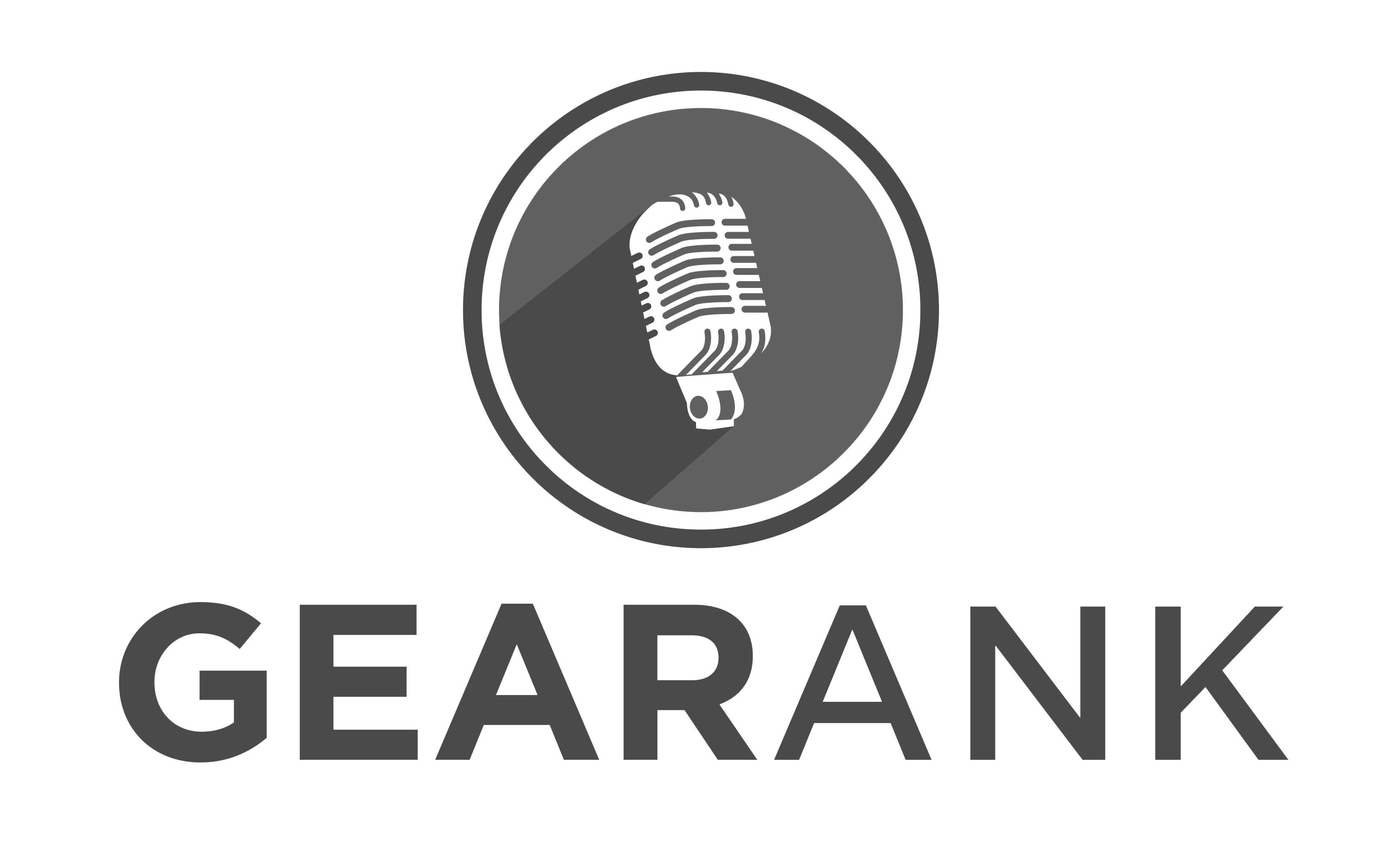
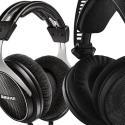
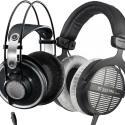
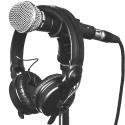


The Yamaha HPH-50 was removed from the recommended list when we published the July 2022 Edition.
Publication of our January 2022 Edition resulted in the following headphones coming off the recommended list above, but you can still see our analysis of them:
I still recommend Sony MDR 7506. Over 35 years, it’s still and always will be the best basic and standard monitor headphones in the whole wide world music industry.
As a result of our January 2021 update the following headphones came off the recommended list above, but you can still see our analysis of them:
The Sony MDR-7520 Headphones have been removed from the recommended list above due to being discontinued.
The following set of headphones came off the recommended list above when we updated this guide in February 2020: KRK KNS 8400.
As a result of the August 2018 update to this guide, the following headphones came off our recommended list above but you can still read what we have to say about them:
Biggest issue for recording headphones are the small 1/8 in jack. The 1/4 in jacks work much better without the adapters.
With today’s update we have removed the Sennheiser HD 280 Pro headphones from this guide but we are still recommending them in our guide to Cheap Studio Headphones.
I forgot to post back at the time, but we did publish that new guide I mentioned: The Best Open-Back Headphones for Mixing and Mastering.
We discussed this in the ‘Things to Consider’ section above, but I’ll add a little to that.
The best solution for mixing is using Studio Monitors.
Next best is open-back headphones and we’ll have a new guide covering this topic very soon.
Then you have the option of using closed-back headphones which is an acceptable way to go if you’re working on a limited budget because you can also use them for recording tracks. You generally shouldn’t record tracks with open-back headphones due to the monitor mix spilling into the new tracks. You might also want closed-back if you’re in an environment where you have to keep the noise down for others.
Don’t forget that technology moves forward – what may have been a ‘hard rule’ a few years ago is becoming a ‘rule of thumb’, and new developments might make it a non-issue in the future.
Hey,
I was under the impression mixing headphones need to be open-back headphones thus I am confused why you would even mention mixing here? Im not tryna be a d*** or anything, but I am actually trying to understand if there’s something that I am msising or do not know yet.
Yo thanks for sharing your best closed-back studio monitoring headphones. The best closed-back mixing headphones for me are the Sennheiser HD 280 Pro because they perform incredibly well for their very cheap price tag.
But if I have to make an unbiased choice, it would be the V-MODA Crossfade M-100. They don’t have an online presence as strong as the Audio Technica ATH-50X or Sony MDR 7506, but these mixing headphones are impressive. I think they should be more popular than they are now.
We haven’t analyzed open backed headphones yet, but we will do so in a future gear guide and we’ll provide a link at the top of this page when it’s done.
Which open back headphones do you recommend for mixing?